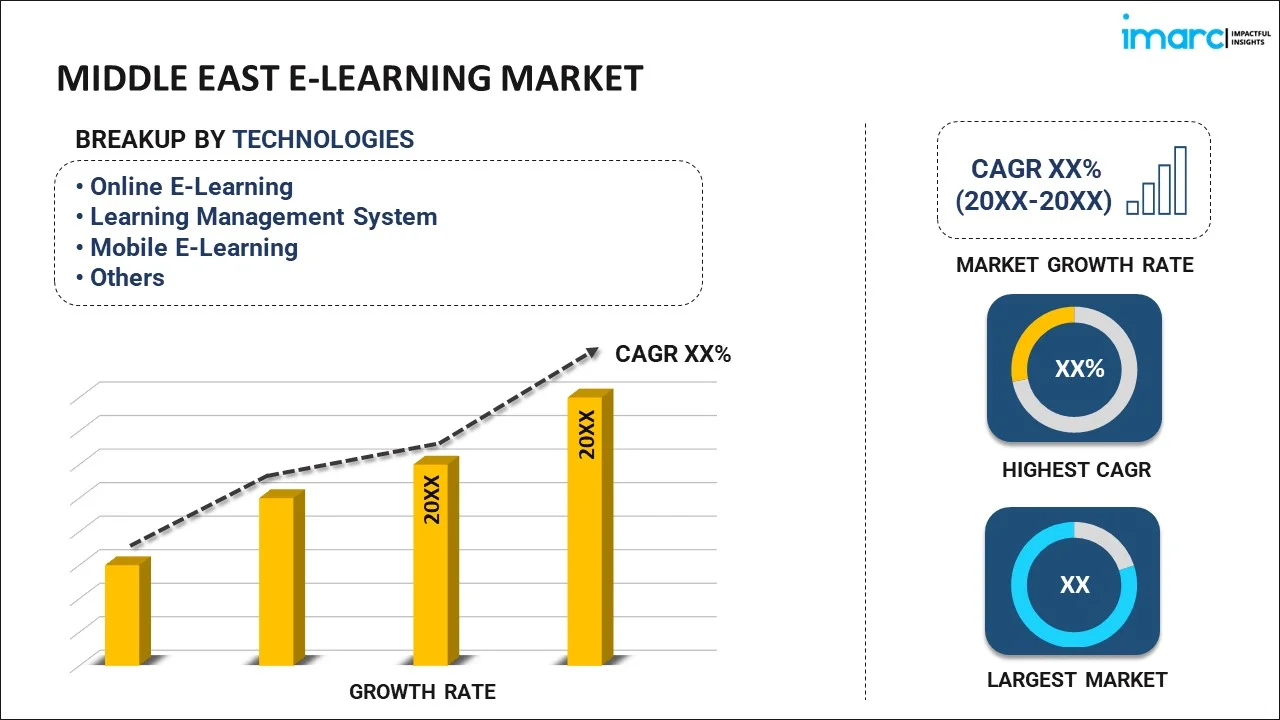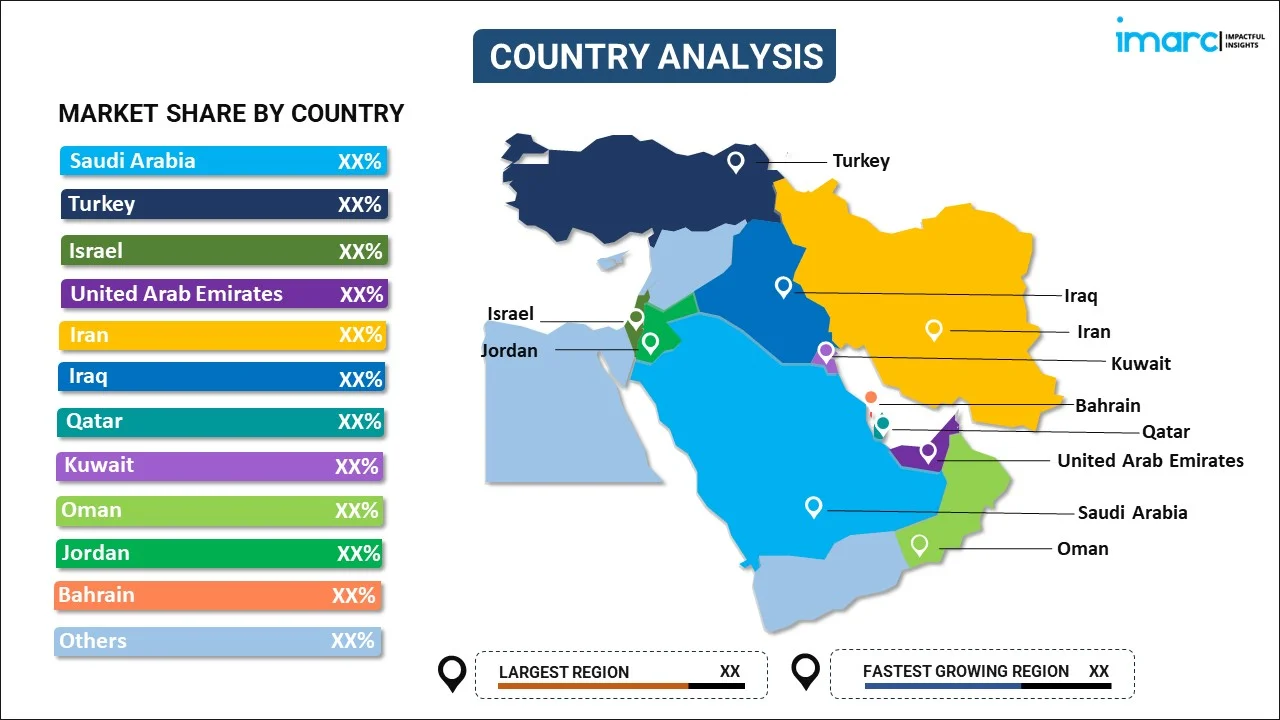
Middle East E-Learning Market Report by Technology (Online E-Learning, Learning Management System, Mobile E-Learning, Rapid E-Learning, Virtual Classroom, and Others), Provider (Services, Content), Application (Academic, Corporate, Government), and Country 2025-2033
Market Overview:
Middle East e-learning market size is projected to exhibit a growth rate (CAGR) of 6.75% during 2025-2033. The increasing advances in technology, such as high-speed internet, mobile devices, and cloud computing, which have significantly enhanced the delivery and accessibility of e-learning content, are driving the market.
|
Report Attribute
|
Key Statistics
|
|---|---|
|
Base Year
|
2024 |
|
Forecast Years
|
2025-2033 |
|
Historical Years
|
2019-2024
|
| Market Growth Rate (2025-2033) | 6.75% |
E-learning, short for electronic learning, refers to the use of electronic technology to deliver educational content and facilitate learning outside the traditional classroom setting. It encompasses a wide range of instructional materials and methodologies, including online courses, digital resources, and interactive multimedia. E-learning provides learners with the flexibility to access educational content anytime, anywhere, as long as they have an internet connection. This approach leverages various digital tools, such as learning management systems, video lectures, and collaborative online platforms, to engage students and enhance their educational experience. E-learning has become increasingly popular due to its accessibility, cost-effectiveness, and ability to cater to diverse learning styles. It has transformed education by breaking down geographical barriers and democratizing access to knowledge, making learning more personalized, interactive, and adaptable to the evolving needs of students in the digital age.
Middle East E-Learning Market Trends:
The e-learning market in the Middle East is experiencing unprecedented growth, primarily driven by the increasing demand for flexible and accessible education. To begin with, the regional penetration of the internet has played a pivotal role in expanding the reach of online learning platforms. As more regions gain reliable internet access, the potential learner base widens, fostering the proliferation of e-learning. Moreover, the widespread adoption of digital education compels institutions and individuals to embrace online learning solutions. This sudden shift in paradigm has illuminated the convenience and efficiency of e-learning, prompting long-term changes in education delivery. Furthermore, advancements in technology, such as artificial intelligence and virtual reality, have enhanced the interactive and immersive aspects of online education. These innovations not only engage learners more effectively but also cater to diverse learning styles. Additionally, the growing emphasis on upskilling and continuous learning in the professional sphere has fueled the demand for e-learning solutions. Employers recognize the need for a skilled workforce in an ever-evolving landscape, driving individuals to seek accessible and targeted online courses to stay competitive. In conclusion, a confluence of factors, including technological advancements and evolving educational paradigms, collectively propels the dynamic expansion of the e-learning market in the Middle East.
Middle East E-Learning Market Segmentation:
IMARC Group provides an analysis of the key trends in each segment of the market, along with forecasts at the regional and country levels for 2025-2033. Our report has categorized the market based on technology, provider, and application.
Technology Insights:

- Online E-Learning
- Learning Management System
- Mobile E-Learning
- Rapid E-Learning
- Virtual Classroom
- Others
The report has provided a detailed breakup and analysis of the market based on the technology. This includes online e-learning, learning management system, mobile e-learning, rapid e-learning, virtual classroom, and others.
Provider Insights:
- Services
- Content
A detailed breakup and analysis of the market based on the provider have also been provided in the report. This includes services and content.
Application Insights:
- Academic
- K-12
- Higher Education
- Vocational Training
- Corporate
- Small and Medium Enterprises
- Large Enterprises
- Government
The report has provided a detailed breakup and analysis of the market based on the application. This includes academic (K-12, higher education, and vocational training), corporate (small and medium enterprises and large enterprises), and government.
Country Insights:

- Saudi Arabia
- Turkey
- Israel
- United Arab Emirates
- Iran
- Iraq
- Qatar
- Kuwait
- Oman
- Jordan
- Bahrain
- Others
The report has also provided a comprehensive analysis of all the major regional markets, which include Saudi Arabia, Turkey, Israel, United Arab Emirates, Iran, Iraq, Qatar, Kuwait, Oman, Jordan, Bahrain, and Others.
Competitive Landscape:
The market research report has also provided a comprehensive analysis of the competitive landscape in the market. Competitive analysis such as market structure, key player positioning, top winning strategies, competitive dashboard, and company evaluation quadrant has been covered in the report. Also, detailed profiles of all major companies have been provided.
Middle East E-Learning Market Report Coverage:
| Report Features | Details |
|---|---|
| Base Year of the Analysis | 2024 |
| Historical Period | 2019-2024 |
| Forecast Period | 2025-2033 |
| Units | Million USD |
| Scope of the Report | Exploration of Historical Trends and Market Outlook, Industry Catalysts and Challenges, Segment-Wise Historical and Future Market Assessment:
|
| Technologies Covered | Online E-Learning, Learning Management System, Mobile E-Learning, Rapid E-Learning, Virtual Classroom, Others |
| Providers Covered | Services, Content |
| Applications Covered |
|
| Countries Covered | Saudi Arabia, Turkey, Israel, United Arab Emirates, Iran, Iraq, Qatar, Kuwait, Oman, Jordan, Bahrain, Others |
| Customization Scope | 10% Free Customization |
| Post-Sale Analyst Support | 10-12 Weeks |
| Delivery Format | PDF and Excel through Email (We can also provide the editable version of the report in PPT/Word format on special request) |
Key Questions Answered in This Report:
- How has the Middle East e-learning market performed so far and how will it perform in the coming years?
- What has been the impact of COVID-19 on the Middle East e-learning market?
- What is the breakup of the Middle East e-learning market on the basis of technology?
- What is the breakup of the Middle East e-learning market on the basis of provider?
- What is the breakup of the Middle East e-learning market on the basis of application?
- What are the various stages in the value chain of the Middle East e-learning market?
- What are the key driving factors and challenges in Middle East e-learning?
- What is the structure of the Middle East e-learning market and who are the key players?
- What is the degree of competition in the Middle East e-learning market?
Key Benefits for Stakeholders:
- IMARC’s industry report offers a comprehensive quantitative analysis of various market segments, historical and current market trends, market forecasts, and dynamics of the Middle East e-learning market from 2019-2033.
- This research report provides the latest information on the market drivers, challenges, and opportunities in the Middle East e-learning market.
- Porter's five forces analysis assist stakeholders in assessing the impact of new entrants, competitive rivalry, supplier power, buyer power, and the threat of substitution. It helps stakeholders to analyze the level of competition within the Middle East e-learning industry and its attractiveness.
- A competitive landscape allows stakeholders to understand their competitive environment and provides an insight into the current positions of key players in the market.
Need more help?
- Speak to our experienced analysts for insights on the current market scenarios.
- Include additional segments and countries to customize the report as per your requirement.
- Gain an unparalleled competitive advantage in your domain by understanding how to utilize the report and positively impacting your operations and revenue.
- For further assistance, please connect with our analysts.
 Inquire Before Buying
Inquire Before Buying
 Speak to an Analyst
Speak to an Analyst
 Request Brochure
Request Brochure
 Request Customization
Request Customization




.webp)




.webp)












